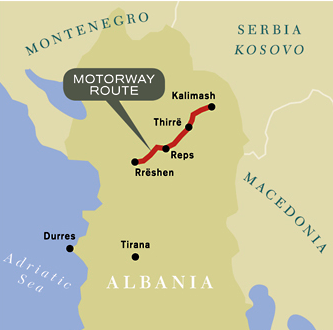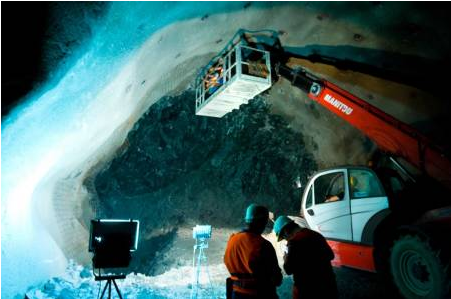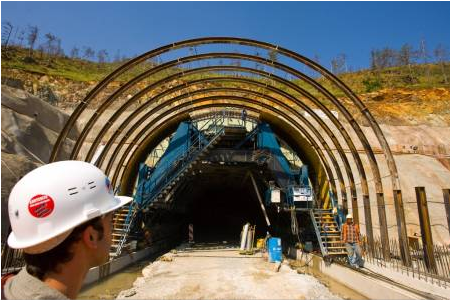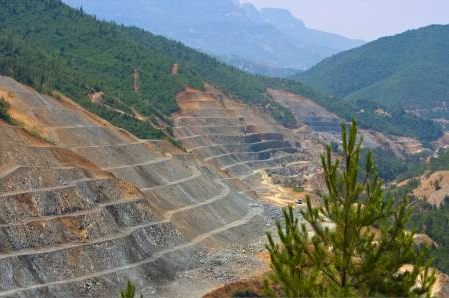Categories
You are here
Tunnel collapse in Albania closes highway
Dr. Sauer of Austria and Müller & Hereth of Germany to analyze technical issues in the tunnel. "The experts are now engaged in developing a plan to address permanent stabilization of the area.
Four months after its celebrated inauguration that brought together the Prime Ministers of two countries and hundreds of cheering public, partial collapse of a highway tunnel in Albania has delayed the opening of the project to traffic.
 The Albanian Ministry of Transportation and Public Works said the collapse occurred in a 5.5km (3.4 mile) tunnel near Thirrë on November 5, but stressed there were no injuries or damage to equipment.
The Albanian Ministry of Transportation and Public Works said the collapse occurred in a 5.5km (3.4 mile) tunnel near Thirrë on November 5, but stressed there were no injuries or damage to equipment.
Bechtel-Enka JV (BEJV) is excavating the tunnel as part of its contract with the Albanian General Roads Directorate to build a 61km (38 mile) four-lane motorway between the town of Rrëshen, to the northern town of Kalimash (Fig 1).
In a written reply to TunnelTalk's request for an interview with the project manager, Bechtel spokesperson Julie Green confirmed yesterday (November 19) a "partial collapse of a 50m section in the central, geologically complex area of the south bore of the twin-tube tunnel."
Green said excavation using modified NATM had been completed in both tubes and crews were completing the lining and mechanical and electrical works in the north bound tunnel, and working on lining, paving, and civil, mechanical and electrical works in the south bound tube.
In a news conference on Tuesday, November 17 the Minister of Transportation and Public Works Sokol Olldashi said the collapsed occurred in a section of the tunnel that had experienced heavy overbreak during excavation. "The situation could be considered already under full control and towards stabilization," said Olldashi. The Minister and Bechtel said the General Roads Directorate has retained engineering experts, including Dr. Sauer of Austria and Müller & Hereth of Germany to analyze technical issues in the tunnel. "The experts are now engaged in developing a plan to address permanent stabilization of the area," said Bechtel's spokesperson.
 Despite the grand opening in early June, only the north bound tube was ever opened. Minister Olldashi said the south bound tunnel was expected to open in September. Instead the Ministry closed both bores of the tunnel in early October when the first signs of trouble were reported.
Despite the grand opening in early June, only the north bound tube was ever opened. Minister Olldashi said the south bound tunnel was expected to open in September. Instead the Ministry closed both bores of the tunnel in early October when the first signs of trouble were reported.
"The tunnel has to be closed in order to allow the contractor to pursue its work to stabilize a short segment where an unstable geological mass is exerting pressure on the wall," said Olldashi to explain the closure in October. Following the collapse he said: "We have prevented any persons, other than specialized experts, to approach the risk zone to stabilize the redistribution of strain and cracks in the rock."
Bechtel did not respond to questions on a possible cause, but excavation was plagued by difficult ground conditions. The alignment runs under Mount Runes, with an altitude of 1,858m (6,100ft) and in some of the most challenging ground conditions on the entire project.
n a published report, Darren Mort, the JV's Prime Contract Manager, said NATM was deemed to be the best method of excavating the 6.4m high tunnel using drill+blast to create the crown followed by the invert. Mort said the plan was to let the rock move some and allow it to stabilize itself while flexible reinforcement was added for extra support. 
The geotechnical report estimated that 83% of the alignment would be split between Class II and III rock needing medium to little support and that only 7% of the alignment would be in Class IV rock, requiring heavy support. In reality 60% of the alignment was in Class IV rock, with 8% in the poorest Class V rock, 32% in Class III rock and none in the most favorable Class I and II rock. According to the design, Class IV and V called for heavy steel support arches at intervals of between 1m and 2m.
Work on the tunnel, designed by Egis Route of France, began in May 2007 with all four faces being excavated concurrently to meet a tight construction program of two years. Five Atlas Copco jumbos - three in the north bore and two in south bore - advanced the 5.5km tunnel and completed excavation by the June 2009 deadline.
The 61km motorway is the central link of the 171km (106 mile) motorway from the port city of Durres on the Adriatic, to Morine on the northeastern border with Kosovo. Once complete the new road is expected to cut travel times from Durres to Kosovo from six to two hours.
